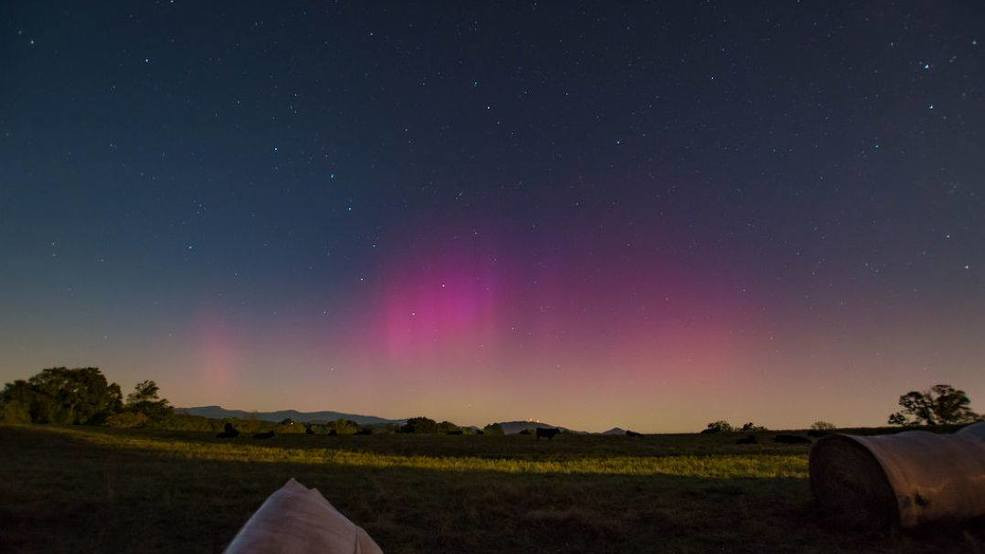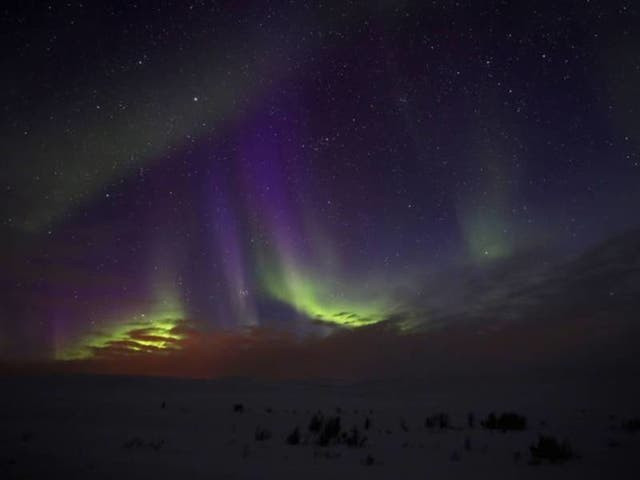A coronal mass ejection (CME) erupted from the sun Tuesday and is projected to arrive at Earth sometime on Thursday. CMEs trigger geomagnetic storms which, if they are strong enough, can produce brighter and more active displays of the northern lights that can be seen further south from the pole and even, in cases like this one, as far south as the United States. This means that the aurora might be visible for many northern states and some of the lower Midwest to Oregon over the next few nights.
Exactly how far south the aurora can be seen depends on the intensity of the storm. Thursday’s storm is not expected to reach the same strength we saw back in May, where people all along the East Coast were reportedly seeing the lights. But it could be enough to make the aurora visible to the northern half of our area. And sky conditions are going to be near perfect for viewing. Thanks to a dominant high-pressure system and an influx of dry air, clouds will not obstruct. Expect clear skies across the region.
The moon should not be too intrusive, either. As the brightest object in the night sky, the moon serves as its own form of light pollution. When trying to view the sky, a new moon is ideal while a full moon can be a hindrance. Thursday has neither of these. Instead, the moon will be in its first quarter phase, meaning there will be some unavoidable light, but nothing too detrimental.
Otherwise, the best way to increase your chances of seeing the lights is to head further north and find a spot with no light pollution and an unobstructed view of the northern sky. If you can, bring your best camera along with you. Even if you can’t see the aurora with the naked eye, many cameras are still capable of capturing the phenomenon. But before you grab your camera and head upstate, make sure you also grab a jacket, if not the hat and gloves as well. Thursday night is forecast to be the chilliest night our area has seen since April. We’ll stay in the 40s in the city and across Long Island, but north and west of town, where you would have a better chance of seeing the northern lights, temperatures are dipping into the mid and lower 30s. In fact, the National Weather Service has issued a frost advisory for much of that area. So if you plan on being out, you’re going to want to make sure you’re bundled up before you start to look up. Then by Friday night chances of seeing the aurora in our immediate area will be gone. You would have to go much further upstate, or even into Canada, to try to glimpse the northern lights this time around.
Northern Lights in Northern Virginia
The Northern Lights may be visible over Northern Virginia again late Oct. 10 into early Oct. 11. A strong geomagnetic storm is underway, and it may give the D.C. area another chance to see the aurora borealis, or Northern Lights, tonight into early tomorrow. The National Oceanic and Atmospheric Administration Space Weather Prediction Center says the aurora may dip as far south as Northern Virginia this evening through Friday morning.
Causes of Geomagnetic Storms
A large sunspot cluster produced a coronal mass ejection, known as a CME, that arrived at Earth at 11:15 a.m., traveling nearly 1.5 million miles per hour, NOAA said on its website. "The CME strength and structure are being closely scrutinized for potential geomagnetic storm intensity, but, G3 levels are now expected due to the magnitude and potential of the CME, therefore G3 or greater warning has been issued," NOAA's forecast said. "G4 (Severe) levels remain likely with the watch still in effect and even a slight chance of G5 (Extreme) levels due to initial observations of the CME strength." CMEs are explosions of plasma and magnetic fields from the sun’s corona and they cause geomagnetic storms when they are directed at Earth, NOAA says.
Potential Impacts of Geomagnetic Storms
"Geomagnetic storms can impact infrastructure in near-Earth orbit and on Earth’s surface, potentially disrupting communications, the electric power grid, navigation, radio and satellite operations," NOAA said. Geomagnetic storms can also trigger spectacular displays of aurora on Earth, and while there is no real way to predict when they might be visible, tonight the possibility is there from sunset through 2 a.m. Friday. Aurora forecasts are based on a geomagnetic measure called the Kp index. For Northern Lights to be visible in the D.C. area, the Kp index needs to be between 7 and 9. You can follow the latest Kp index at the University of Alaska Geophysical Institute, and see a map of predicted aurora activity at the NOAA's Space Weather Prediction Center. The institute predicts the Kp index to reach 8 between 5 p.m. today and 2 a.m. Friday. Dark skies are best to view the phenomena.
Seeing the Northern Lights: Tips for Viewing
In May, another powerful solar storm brought the aurora as far south as Texas and Florida and the lights were visible along much of the East Coast. If you’re looking to catch a glimpse of the Northern Lights, the best chance is to head out to a dark location with an unobstructed view of the northern sky. The further north you go, the better your chances of seeing the aurora. Make sure you bundle up as it will be cold out. And be patient, as it may take some time for the aurora to appear.
Aurora Viewing Locations in Northern Virginia
Several locations in Northern Virginia offer excellent views of the night sky, making them ideal for viewing the aurora. These locations include:
-
Shenandoah National Park: With its dark skies and stunning mountain views, Shenandoah National Park is a prime spot for aurora viewing.
-
Sky Meadows State Park: This park offers several hiking trails and scenic overlooks, providing opportunities to escape light pollution and find a clear view of the northern sky.
-
Prince William Forest Park: This park features a variety of habitats, including forests, meadows, and streams, offering a secluded escape for aurora viewing.
Catching the Northern Lights: A Final Thought
The Northern Lights are a truly amazing natural phenomenon, and while they are not always visible in Northern Virginia, this weekend offers a great opportunity to see them. So bundle up, head out to a dark location, and see if you can catch a glimpse of this dazzling display.


















